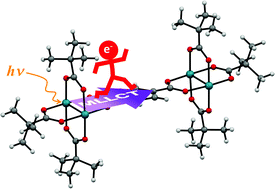Experimental and theoretical study of dimer-of-dimers-type tetrarhodium(ii) complexes bridged by 1,4-benzenedicarboxylate linkers†
Abstract
Two dimer-of-dimers-type tetrarhodium complexes, [Rh4(piv)6(BDC)] ([1]; piv = pivalate) and [Rh4(piv)6(F4BDC)] ([2]), in which two paddlewheel-type dirhodium units are linked by 1,4-benzenedicarboxylate (BDC) and 1,4-tetrafluorobenzenedicarboxylate (F4BDC), respectively, have been synthesized and characterized via single-crystal X-ray diffraction analyses, ESI-MS, 1H NMR, infrared spectroscopy, Raman spectroscopy, and elemental analyses. Crystal structure analyses of [1(THF)4] and [2(THF)4], which are crystallized from THF solutions of [1] and [2], respectively, revealed that dihedral angles (ϕ) between two –CO2 units and phenyl rings of the BDC linker in [1(THF)4] are almost co-planar (ϕ = 2.8°), whereas those of the F4BDC linker in [2(THF)4] are largely inclined (ϕ = 78.3°). Density functional theory calculations clarified that (i) their dihedral angles of optimized geometries of [1(THF)4] and [2(THF)4] are almost the same as their experimental geometries, and (ii) the rotation energy barriers of phenyl moieties in [1(THF)4] and [2(THF)4] estimated by potential energy surface analyses are 12.0 and 8.4 kcal mol−1, respectively, indicating that hydrogen bondings are formed between two –CO2 units and four hydrogen atoms of phenyl rings of the BDC linker in [1(THF)4], whereas two –CO2 units and four fluorine groups on the phenyl ring of the F4BDC linker in [2(THF)4] are electrostatically and sterically repulsed. Electrochemical properties and electronic structures of [1(THF)4] and [2(THF)4] are strongly influenced by the electronic states of dicarboxylate linkers, whereas absorption spectra are strongly influenced by the dihedral angles between two –CO2 units and phenyl rings of dicarboxylate linkers.



 Please wait while we load your content...
Please wait while we load your content...